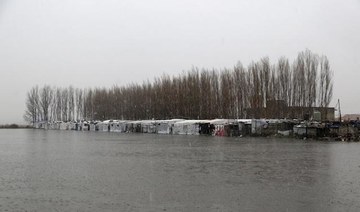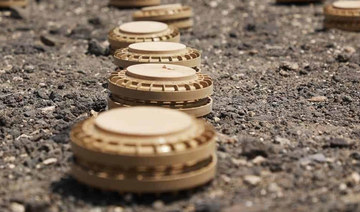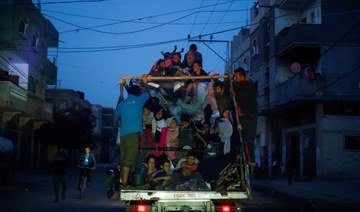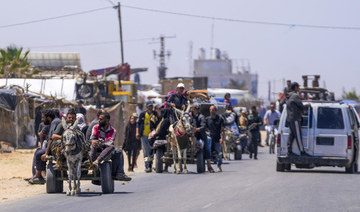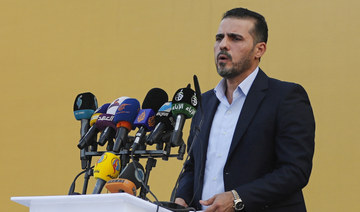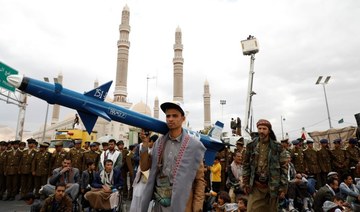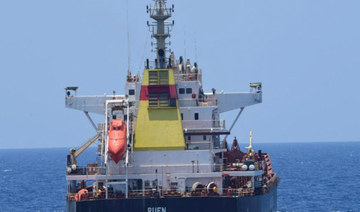QAMISHLI, Syria: Three years ago, the world watched as the Syrian Democratic Forces and the Global Coalition to Defeat ISIS battled the remnants of Daesh in the extremist group’s last territorial holdout of Baghouz.
Having once controlled an area the size of England, the terror group had been forced to retreat into an area covering just a few hundred square meters, where they dug in behind razor wire, earthworks and fields laid with thousands of landmines.
When the fighting was finally over and the last Daesh positions had been cleared, SDF morale skyrocketed and there were days of celebrations across the Autonomous Administration of North and East Syria.
But after the guns had fallen silent, the SDF and its international allies were left with the daunting task of clearing landmines and other unexploded ordnance from the battlefield so that families could return to their land.
Years later, the work continues, hampered by security threats posed by Daesh holdouts, a lack of funding from international aid agencies, and the political complexities of the region.

An expat de-miner, near Jurniya in Syria. (Ali Ali)
On Dec. 8, 2005, the UN General Assembly declared that an International Day for Mine Awareness and Assistance in Mine Action would be observed on April 4 each year.
Since the Anti-Personnel Mine Ban Convention, also known as the Ottawa Treaty, opened for signatures in 1997, 164 countries have ratified or acceded to it. In 2014, the signatories agreed to the complete the clearance of all landmines by 2025. However, these indiscriminate weapons continue to be used by state and non-state actors alike in conflict zones.
From Daesh’s final strongholds in Deir ez-Zor and its former de-facto capital of Raqqa, to areas such as Kobane, which was liberated as long ago as 2015, roads, fields and even residential buildings are still dotted with landmines that continue to claim lives and limbs.
The task of clearing these explosive remnants of war has fallen to the Roj Mine Control Organization, a non-governmental humanitarian organization working in coordination with the Northeast Syria Mine Action Center, the de-facto umbrella group for mine-clearing efforts in Syria’s autonomous northeast.
Local and international agencies say they have collectively removed about 35,000 anti-personnel and anti-vehicle landmines throughout the region but thousands more remain.

Disarmed testing mine, near Jurniya in Syria. (Ali Ali)
At every checkpoint on the main highways between Raqqa, Hasakah and Deir ez-Zor, signs are posted that show pictures of various types of mines and explosive ordnance alongside a message in giant red letters that warns: “Danger! Stay away! Don’t touch! Report quickly! Spread awareness! Protect yourself from the threat of mines, remnants of war, and suspicious and dangerous areas. Don’t go exploring. If you see something suspicious, tell the concerned authorities.”
From all accounts, such warnings are amply justified.
“I was 9 or 10 years old,” Omar Al-Omar, who is now 13, told Arab News at his home in Raqqa. “I was playing in front of our house when a mine exploded. I was in the hospital for two months and 10 days. I was unable to move around.”
FASTFACT
* International Day for Mine Awareness and Assistance in Mine Action, on April 4, aims to raise awareness about landmines and progress toward their eradication.
Both of Omar’s legs had to be amputated. He has regained some mobility thanks to prosthetic limbs that were provided by the Hope Makers Center in Raqqa, a charitable organization that has since had to suspend many of its services as a result of lack of funding. Someday, he said, he hopes to become a doctor.
The Social Affairs and Labor Committee of Raqqa Civil Council has documented about 2,500 individuals who, like Omar, were maimed by landmines in the city alone. Council worker Amira Hussein believes the true figure is much higher.

The scarred arm of 16-year-old Ahmed, wounded by a mine in October last year, in Kobane. (Ali Ali)
“If you look around Raqqa, on every street you will see a man, woman or child with a missing limb,” she told Arab News, scrolling through photos on her laptop of local children with missing limbs and scars from burns.
“Even in 2022, the issue of mines is still relevant. People thought that once Raqqa was liberated their lives would return to normal. But when they went back, mines went off in their homes.”
Much of the work carried out by local and international mine-disposal agencies has been focused on Raqqa, as the city was heavily mined during the years from 2014 to 2017 when it was under Daesh control.
Although crude improvised explosive devices left behind by retreating Daesh militants are still frequently discovered in the city, the bulk of the mine-disposal work is taking place in the countryside.
“There were a lot of mine explosions in the beginning but now there are far fewer,” Yusuf, a team administrator at the Raqqa Internal Security Forces’ Explosives Ordnance Disposal Unit, told Arab News.
“We maybe see mines only 1 percent of the time. Our team has cleared 80 percent of the city of Raqqa of mines.”

A Raqqa Internal Security Forces (Asayish) EOD team member in Syria. (Ali Ali)
However, not all of the explosive devices cleared by the Raqqa EODU are remnants of the battle to liberate the city. Daesh sleeper cells continue to operate here, planting explosives along roadsides and in buildings.
The 60-member Raqqa EODU team can respond to a report of an explosive device in less than 10 minutes, said Yusuf. This efficiency and dedication comes at a cost, however: 19 of its members have been killed in the line of duty.
While clearly highly dangerous, mine-disposal work can also be tedious and time-consuming. An international aid agency operating in Raqqa, which asked not to be identified for security reasons, has been systematically clearing the Tal Othman to Jurniya road for months now, often progressing just a few meters each day.
Locals said they watched Daesh militants lay mines along the road for seven months before the area was finally liberated in 2017. After three weeks of painstaking work, mine-disposal experts were able to locate and destroy two anti-tank mines.
Rocks painted red, marking the boundaries of safe areas, line the edge of the road where the disposal crews work, while rocks painted white denote safe paths. Once the road has been made completely safe and repaved, communities in Raqqa’s western countryside will once again have access to markets in Manbij city.
“We are making a sacrifice for the future,” one foreign mine-disposal expert working at the site told Arab News, his face obscured by a protective visor. He cannot be named for security reasons.
“The last time I went on holiday, two children died in Raqqa. This stays with you.”

De-mining markers, near Shaddadi in Syria. (Ali Ali)
As is the case in Raqqa, parts of Deir ez-Zor in the east of the country are also plagued by the explosive remnants of Daesh’s last stand. Here the group’s sleeper cells, operating close to the border with Iraq, continue to pose a threat to landmine-disposal teams.
The Monitoring and Observation Desk, an independent conflict observatory in northeastern Syria, documented 15 attacks on local security forces by Daesh remnants in the Deir ez-Zor region in February alone, two of which were carried out using landmines.
Besides the difficult task of removing and destroying mines, local and international agencies operating in Deir ez-Zor also work to raise community awareness of the threat, erect warning signs, and distribute literature about the threats posed by explosive remnants and how people can stay safe.
Agencies such as the Roj Mine Control Organization work directly with farming communities and schools to teach agricultural workers and children — two of the groups most at risk — how to recognize explosive devices and what to do if they stumble upon one.
The RMCO said it has conducted more than 1,400 mine-awareness sessions, during which it has spoken to about 17,700 people across northern and eastern Syria. Meanwhile, its mine-clearance teams claim to have removed more than 19,000 devices.
Although the RMCO operatives work to established international standards, they often lack the heavy armored machinery and personal protective equipment used by better-funded foreign agencies, making their work slower and at times much more dangerous.
The same is true in the far north of Syria, close to the border with Turkey, where the countryside is still littered with landmines and other explosives left over from the battle to liberate Kobane in 2015.
In a small village to the west of the city, a pair of Russian helicopters buzz overhead. On the brow of a nearby hill, a Turkish military post looks down from the imposing border wall.
Mohammed Sheikhmous, a farmer who lives just 50 meters from the border, lost one of his sons to a landmine.

Stephen Goose, director of Human Rights Watch's Arms Division. (AFP/File Photo)
“My son went out with the sheep and stepped on a mine,” Sheikhmous told Arab News. “There was nothing left of him. We had to gather his body parts.”
Before that incident, another of his sons had suffered serious injuries from a landmine blast, he said, which put the boy in hospital for two months and left him with permanent scars on his arms and legs.
In 2021 alone, 12 people in villages around Kobane lost their lives to mines, half of them children.
Because of the political complexities in this part of Syria, it is difficult for landmine-clearance teams to get permission to gain access and work. Agencies must somehow find a way to coordinate with local militias, Syrian regime forces, and the Russian and Turkish forces that have jointly patrolled the countryside around Kobane since October 2019 as part of a “de-escalation” agreement.
Until such complexities are resolved, farming communities straddling the border wil be compelled to live with this invisible, yet lethal threat.
“This is a burden that will never end, even with the end of the war,” said Hussein, the Raqqa Civil Council worker. “The mines that were planted are still there.
“Many people are still facing these threats. They can’t go home because they never know at what moment their lives will be threatened.”




